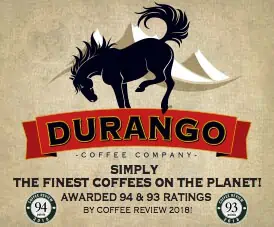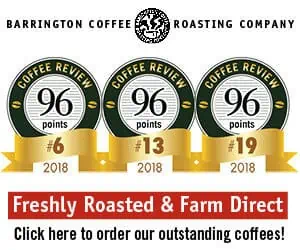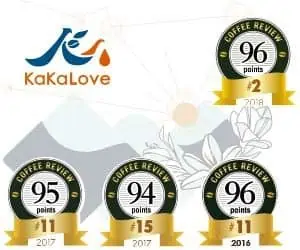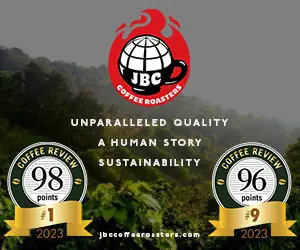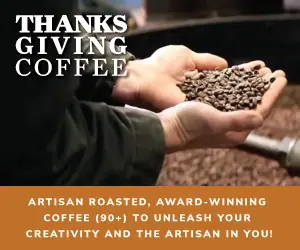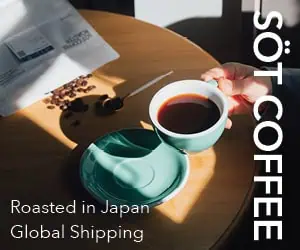Besides providing readers with some recommendations for fine dark-roast coffees, I set up this
co-cupping with John Weaver of Peet’s Coffee to find out whether the thin-bodied, burned dark
roasts I so often taste from American roasters are my problem or the coffees’ problem.
By all measures, John Weaver ought to know about dark roasts. For the past 23 years he
has been roast master of the coffee company that is to dark-roasting what Abner Doubleday is to
baseball. Although Alfred Peet may not have invented specialty coffee in the United States, only
reinvented it, he certainly originated and pretty much perfected the contemporary American art
of extreme dark-roasting, an art that, at its best, expands body and adds a pungent roastiness to
the cup while more or less maintaining the distinctiveness of the green coffee. Starbucks adopted
a less-extreme version of Alfred Peet’s roasting style, popularized it, and by now every small
roasting company in the country appears to have jumped on the dark-roast bandwagon. And,
although Alfred Peet tells people that Peet’s no longer roasts the way it did when he owned the
company many years ago, John Weaver, a man whom Alfred Peet personally trained, would
seem to be as close as we can get to the original potential of the American dark-roast style
without trying to lure Alfred himself out of his woodsy retreat in North Berkeley.
Twenty-Three Coffees, Ten Roasters
John and I cupped (separately, not together) twenty-three dark-roasted coffees from ten different
American roasters (none from Peet’s, of course). I am always careful to conceal the identity of
coffees both from myself and from my co-cuppers until our blind assessments are finalized, and I
was particularly careful to conceal the coffees’ identities from John, given he would be passing
judgment on coffees produced by companies that could be perceived as Peet’s competitors.
Only Seven over 80
So how did the twenty-three dark roasts fare?
Not very well, although several impressive examples of skillful roasting and coffee
sourcing turned up. Of the twenty-three samples, only seven attracted a rating of 80 or over.
Consequently, readers of this article should be aware that coffees reviewed here that scored in the
80s, even the low 80s, could well be among the better dark roast experiences this country has to
offer.
And, if John’s scores are any indication, I am not some evil character assassin of dark
roast reputations. In most cases John and I recorded almost identical scores; in other cases I came
in significantly higher than he did. The main difference between us, it would seem, is my
tendency to overlook light body if offered some compensatingly interesting aromatics and
nuance. Two of the characteristics of Peet’s “deep” roasting style are full body and pungent
authority, which may be the reason John was merciless toward coffees that came in thin or
showed signs of a shallow-flavored listlessness. I am not so demanding in this respect. If a light-
bodied coffee displays interesting flavor notes, as this month’s Capricorn Dark Sumatra does, I
tend to read the cup as “delicate” rather than thin.
We both were critical of coffees that displayed burned (as opposed to roasty or pungent)
tones, but I seemed to be considerably more critical than John of bitterness and astringency. In at
least two cases John praised the finish of coffees that I felt were at least partially marred by a
palate-drying astringency.
What Went Wrong
What about the sixteen samples that attracted ratings lower than 80? One of those sixteen coffees
– a Starbucks Mocha Java blend – is reviewed here. It seems only fair that the roasting company
that, in popular mythology at least, is most identified with dark roasting ought to appear in this
review even if the particular coffee from that company up for review didn’t quite nudge its way
over 80. In fact, Starbucks has moderated its roast style considerably in recent years, and its
featured single-origin coffees typically are roasted much lighter than many coffees produced by
its competitors. And John, at least, felt that the reviewed Starbucks blend could have been helped
by an even darker roast style. Thus the main problem with the Starbucks blend reviewed here
was not over roasting, but what appeared to be a listless green coffee roasted without much
sensitivity.
Which pretty much sums up the story with the other fourteen samples rated under 80.
Either the green coffee did not stand up to the roast style applied to it, or the roast itself was
flawed in some way.
Dark roasting is difficult, much more difficult than bringing coffees to a satisfying medium
or medium-dark roast style. The margin for error narrows as the roast darkens, and it is easy to
burn the beans, introduce metallic or rubbery tones, or fail to cool them decisively, flattening
flavor.
Finally, a couple of the samples were brought to such dark roast levels that there would
be no way of saving them, no matter how tactful and sensitive the roast procedure. One sample
was roasted to an Agtron reading (M-Basic or gourmet scale) of 17 (both whole bean and
ground). John tells me that Peet’s French Roast, for example, is roasted to around Agtron 22.
And 20 is usually considered as dark as it is feasible to roast coffee. Understandably, this coffee
displayed – quite literally – no flavor whatsoever in the cup beyond a bitter, burned sensation. It
was produced by a specialty roaster whose coffees are usually excellent, by the way, and
hopefully was an aberration.
Dark-Roast Lessons
I am not sure what the lesson is here for the buyer of dark-roast coffees. Choose a roaster that
knows what its doing, I guess. For the producer of dark-roast coffees, the lessons are clearer, I’m
afraid: pick the right coffees for dark roasting (distinctive in flavor, sturdy in character, but not
too sharply acidy), bring the roast along slowly, cool decisively, don’t roast the coffee so dark
that nothing whatsoever can save it, and, above all, relentlessly taste what you’re sending out to
your customers.

